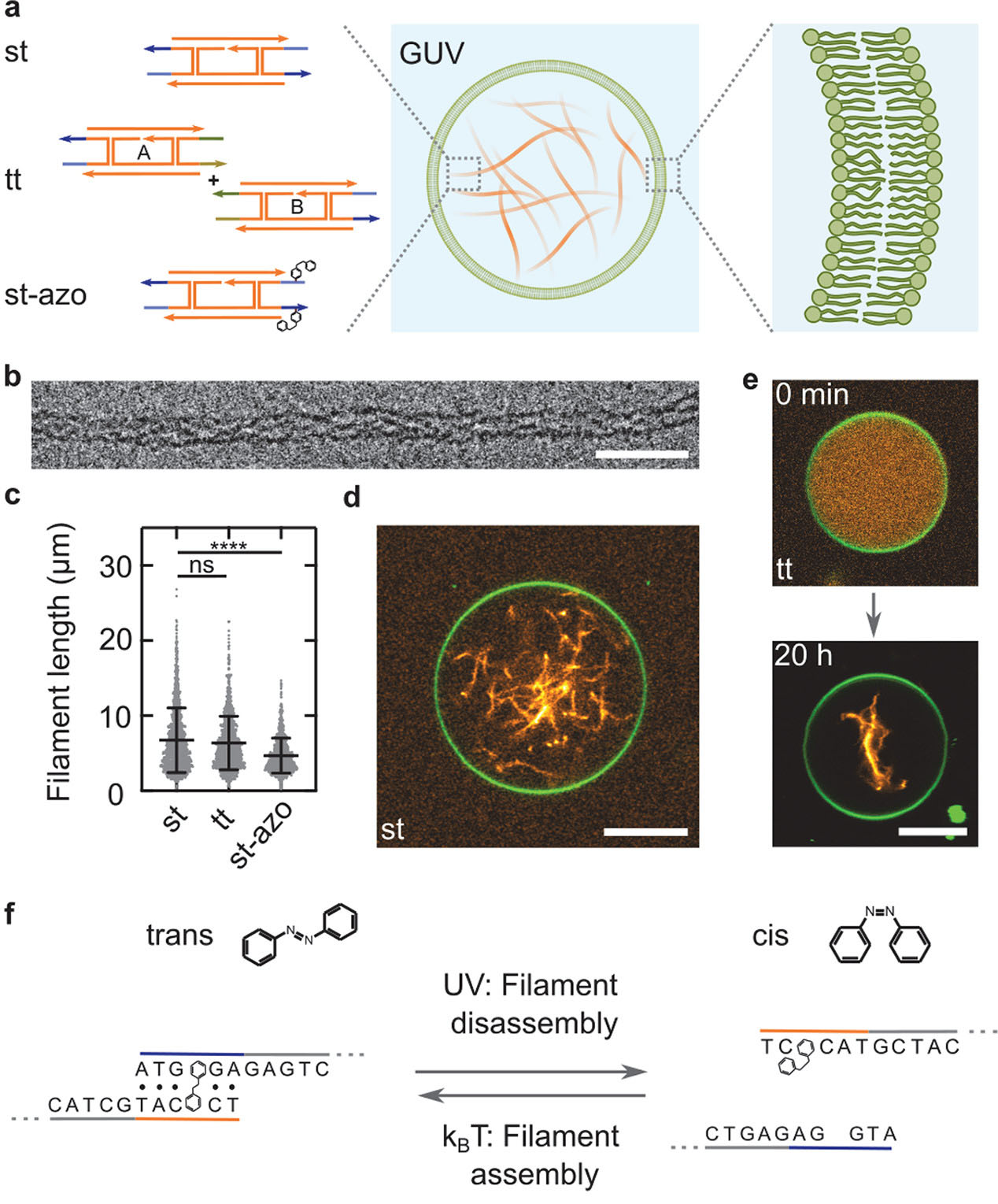| May 04, 2022 |
Bottom-up assembly of synthetic cells with DNA nanotechnology
(Nanowerk News) In much the same way that each of our bodies depends on bones for mechanical integrity and strength, each cell within our bodies is mechanically supported by a skeleton of composite materials including protein polymers (such as actin filaments) and motor proteins (myosin), called the cytoskeleton. The cytoskeleton is an active material that maintains three-dimensional shape and internal organization, enables some cell motion, and plays important roles in both intra-cellular transport and cellular division.
|
|
Being able to engineer multifunctional cytoskeletons for synthetic cells would bring bring us closer toward the audacious vision of engineering life from the bottom up.
|
|
Towards that goal researchers now have realized the de novo assembly of entirely artificial DNA-based cytoskeletons composed of DNA filaments and with programmed multifunctionality inside synthetic cells.
|
|
They reported these findings in ACS Nano ("Bottom-Up Assembly of Synthetic Cells with a DNA Cytoskeleton")
|
 |
| DNA cytoskeletons can be assembled reversibly inside GUVs as lipid-bilayer-enclosed synthetic cell models. (a) Schematic representation of a GUV containing a DNA cytoskeleton composed of DNA filaments. DNA cytoskeletons were assembled from a single tile (st) with sticky overhangs, two tiles (tt) with orthogonal complementarity, or single tiles modified internally with two azobenzene moieties (st-azo). The asterisk indicates the position of a single-stranded overhang modified with a fluorophore. (b) Cryo-electron micrograph of an st DNA filament. Scale bar: 50 nm. (c) DNA filament length (n > 1000 filaments, mean ± SD). The st and tt filaments have the same length (p = 0.16), and st-azo filaments are shorter (p ≤ 0.001). (d) Confocal image of an st DNA cytoskeleton (orange, labeled with Cy3, λex = 561 nm) inside a GUV (green, 69% DOPC, 30% DOPG, 1% Atto488-DOPE, λex = 488 nm). Scale bar: 10 µm. (e) Confocal images of tt cytoskeletons prior to (0 h) and after assembly (20 h) inside a GUV. Scale bar: 10 µm. (f) Schematic representation of the st overhang modified with azobenzene (st-azo) for reversible cytoskeleton assembly with UV light. (Reprinted with permission by American Chemical Society)
|
|
DNA nanotechnology allows nanoscale objects that self-assemble into predefined architectures, in particular DNA filaments, to be precisely and programmably designed.
|
|
To realize a diverse set of functions inside giant unilamellar lipid vesicles (GUVs) and use nucleic acids as engineerable and inherently biocompatible molecular building blocks, the team used three different sets of DNA tiles composed of five single-stranded DNA oligomers that self-assemble into hollow filamentous DNA nanotubes.
|
|
These functions include the reversible light-mediated filament assembly and disassembly, DNA bundles with precise persistence lengths to trigger the formation of ring-like structures, and the formation of DNA cortices that can deform GUVs from within.
|
|
The authors point out that these are only a few examples of conceivable functions of DNA-based cytoskeletons due to the variety of possible DNA structures. In the future, it will be especially exciting to equip DNA filaments with molecular motors for intracellular cargo transport, force generation and contractility.
|

 By
Michael
Berger
– Michael is author of three books by the Royal Society of Chemistry:
Nano-Society: Pushing the Boundaries of Technology,
Nanotechnology: The Future is Tiny, and
Nanoengineering: The Skills and Tools Making Technology Invisible
Copyright ©
Nanowerk LLC
By
Michael
Berger
– Michael is author of three books by the Royal Society of Chemistry:
Nano-Society: Pushing the Boundaries of Technology,
Nanotechnology: The Future is Tiny, and
Nanoengineering: The Skills and Tools Making Technology Invisible
Copyright ©
Nanowerk LLC
